In an attempt to keep my Peru blogging in sequence, I will go back in time to mid August and continue writing in chronological order from there. You may recall, in my last post we had driven from Arequipa to Puno in the deep south of Peru, stopping along the way to see three species of flamingos and other highland puna birds.
August 18, 2022
Laura and I had been on the go for a while and the errands were beginning to pile up. We took the morning of August 18 to sleep-in, make a leisurely breakfast in the apartment that we had rented, do the laundry and catch up on journaling/photo editing. By the early afternoon we were feeling a little restless and so we headed out to the shores of Lago Titicaca in downtown Puno.
 |
| Malecón Puno, Puno, Peru |
The Titicaca Grebe is a flightless species with a limited range in southern Peru and adjacent Bolivia. This endangered species lives mainly on massive Lago Titicaca, though it can be found on a few neighbouring waterbodies as well. Unlike the rare Junín Grebe which we had seen a few weeks earlier, finding the Titicaca Grebe does not typically require a boat trip. Several vantage points along the lakeshore provide excellent chances of spotting some.
Laura and I spent a few hours walking along a pier that had been constructed in one corner of the lake by downtown Puno. This is a popular spot for locals and tourists alike to stroll, hang out, and enjoy the sunshine and beautiful scenery. It also happens to be an excellent birding location. Ducks, ibises, gulls and shorebirds litter the mudflats and shallows, while Plumbeous Rails walk along the reed edges, seemingly oblivious to the people passing by.
 |
| Plumbeous Rail - Malecón Puno, Puno, Peru |
Sometimes, Titicaca Grebes can be seen from the pier and so we kept watch for one. This was unsuccessful but we enjoyed the walk, anyways. Photographic opportunities were abundant, while Laura added a lifer in Yellow-winged Blackbird.
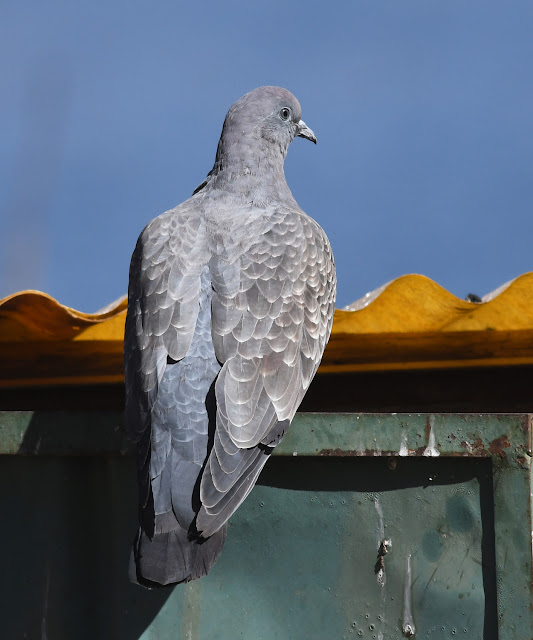 |
| Spot-winged Pigeon - Malecón Puno, Puno, Peru |
 |
| Common Gallinule baby - Malecón Puno, Puno, Peru |
 |
| Yellow-winged Blackbird - Malecón Puno, Puno, Peru |
I made an effort to improve my photos of various duck species.
 |
| Yellow-billed Teal - Malecón Puno, Puno, Peru |
 |
| Yellow-billed Pintail - Malecón Puno, Puno, Peru |
 |
| Puna Teal - Malecón Puno, Puno, Peru |
 |
| Cinnamon Teal - Malecón Puno, Puno, Peru |
A healthy population of Mountain Guinea Pigs resides in the marshes fringing Lago Titicaca.
 |
| Mountain Guinea Pig (Cavia tschudii) - Malecón Puno, Puno, Peru |
 |
| Mountain Guinea Pig (Cavia tschudii) - Malecón Puno, Puno, Peru |
Still grebe-less after an hour and a half on the pier, Laura and I backtracked to the car and drove southeastwards along the coast, leaving the city behind us. My chosen destination was a high viewpoint where Titicaca Grebes can sometimes be observed from.
It took us all of ten seconds of scoping before the first Titicaca Grebes swam into view!
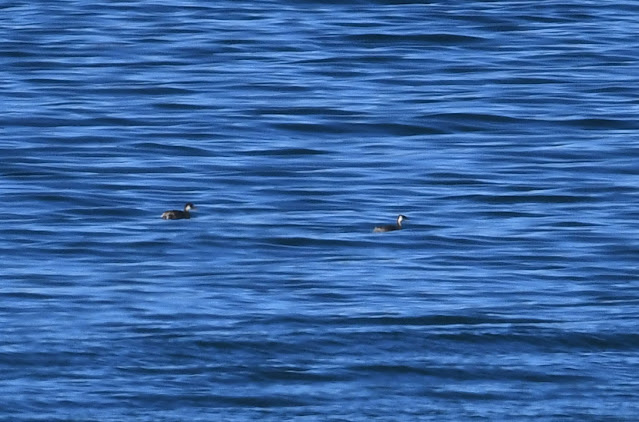 |
| Titicaca Grebes - Humedales Chucuito, Puno, Peru |
We spent around twenty minutes here, enjoying the distant scope views of the grebes. This was another example where I was glad that I had decided to pack the scope for our trip. Without it, the views would have been barely adequate for identification as they were rather far from our location.
 |
| Titicaca Grebes - Humedales Chucuito, Puno, Peru |
While scoping the lake, we enjoyed a close flyby of a Mountain Caracara carrying nesting material, as well as a couple of attractive Black Siskins.
 |
| Mountain Caracara - Humedales Chucuito, Puno, Peru |
 |
| Mountain Caracara - Humedales Chucuito, Puno, Peru |
August 19, 2022
Laura and I had booked three nights at the apartment in Puno, meaning that we still had another full day to explore the area. We made the decision to travel a little further afield and visit the Moquegua area. This is a region that receives very little birder traffic other than a couple of locals: it is way off the beaten birding track. That being said, a handful of species can be found in Moquegua that are otherwise difficult in Peru, including the Lesser Rhea and Puna Miner.
We left early and watched the sun rise as we navigated southwards past frosty puna grasslands and rugged mountains.
 |
| Aguas termales - Moquegua, Peru |
Our first stop was a dirt track running parallel to a small creek, still partially frozen. The air was perfectly calm, making for great listening conditions. I was hoping to find Puna Tinamous here, but they were strangely silent. It must be the time of year.
 |
| Moquegua, Peru |
We found a few birds on our short walk including several Gray-breasted Seedsnipes and Common Miners, and a pair of Puna Yellow-Finches. Upon returning to the car we noticed a ground tyrant. We repositioned ourselves to obtain a less-backlit view and determined that it was a Black-fronted Ground-Tyrant. This is an austral migrant that appears in small numbers each year in the mountains of far southern Peru.
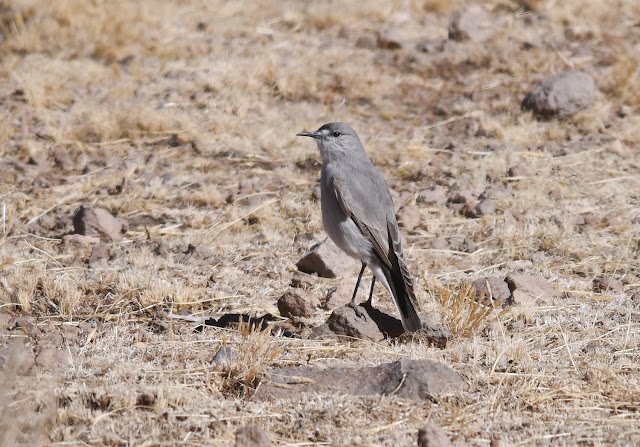 |
| Black-fronted Ground-Tyrant - Moquegua, Peru |
Mountain Viscachas are a common sight on rocky slopes at this elevation. This one seemed to be enjoying the sun's rays that were slowly warming the landscape.
 |
| Mountain Viscacha - Moquegua, Peru |
We stopped at another area where a bridge crossed a small, frozen creek through puna grasslands.
 |
| Moquegua, Peru |
 |
| Moquegua, Peru |
Again, we struck out with the tinamous. But we easily found another target of ours, the Puna Miner. This species has a very limited range in Peru, but here in Moquegua they are reasonably common.
 |
| Puna Miner - Moquegua, Peru |
Somehow, a nice diversity of butterflies can thrive well above 4000m in elevation. We observed quite a few individuals of this species which I have tentatively identified as Infraphulia madeleinea.
 |
| Infraphulia madeleinea - Moquegua, Peru |
A pair of White-winged Cinclodes bathed in an open section of creek alongside a Puna Ground-Tyrant.
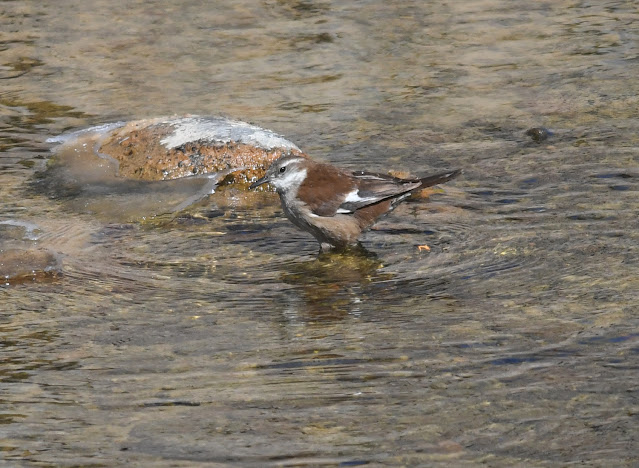 |
| White-winged Cinclodes - Moquegua, Peru |
 |
| Puna Ground-Tyrant - Moquegua, Peru |
The sun had been out long enough that it slowly began to melt the frozen layer on top of the creek. It was also powerful enough to draw several lizards out of the woodwork. This is a species of
Liolaemus, a highly diverse South American genus totalling well over 200 species with many more likely to be described in the future. Most species are resident in the southern Andes.
 |
| Liolaemus sp. - Moquegua, Peru |
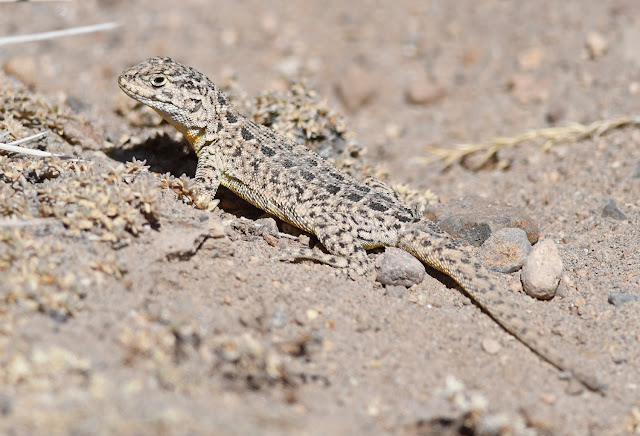 |
| Liolaemus sp. - Moquegua, Peru |
As we climbed the bank back to the car, we caught sight of an owl flying under the bridge and disappearing down the creek. A Great Horned Owl! We grabbed the scope and hiked back through the bunchgrass until Laura spotted the gorgeous bird perched alongside the crest of the creekbed.
 |
| Great Horned Owl - Moquegua, Peru |
Great Horned Owls have a surprisingly large range, being found throughout much of the Americas, mainly avoiding the high Arctic, parts of Central America and Amazonia. These southern Andean individuals are absolutely gorgeous. They blend in quite well with the browns and grays of their arid environment.
Still without some of our main bird targets for the day, Laura and I continued on to an area where Lesser Rheas are often reported. These huge birds should be quite easy to spot on the open landscape, but they are quite rare in the northern part of their range here in Moquegua.
 |
| Moquegua, Peru |
Laura and I stopped at the site of a former wetland which appeared to have mostly dried up. White-throated Sierra Finches had been reported from here in the past. Though our walk was largely birdless as the relentless puna wind had fired up, we finally spotted our first Puna Tinamous. They quickly ran away from us up and over a gravel slope. Luckily, we would obtain better views a little while later at a different site. This time, the tinamous were right beside the road!
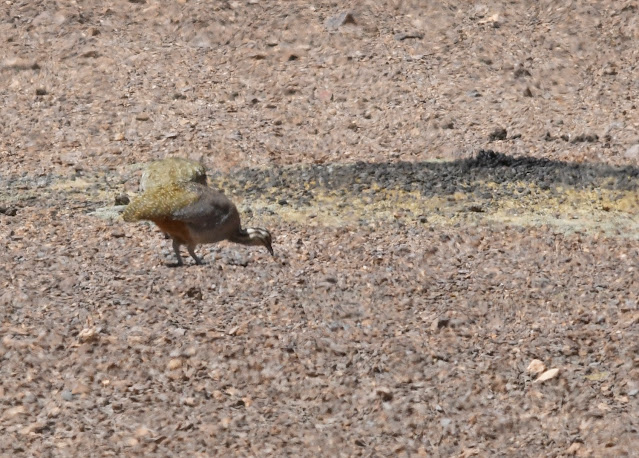 |
| Puna Tinamou - Moquegua, Peru |
Puna Tinamous are kind of ridiculous looking. It is almost as if they were created out of three or four different bird species spliced together poorly with Photoshop.
 |
| Puna Tinamou - Moquequa, Peru |
Laura and I enjoyed hiking in this area, even if it left us a little breathless since the elevation was around 4700m. Once we left the roadside and climbed over a small rise it was just us and the mountains.
 |
| Moquegua, Peru |
We still had a 2.5 hour drive ahead of us back to Puno, so after consuming our lunch of sandwiches and fruit we began the journey back. All the while we scanned for rheas, though we did not find much other than herds of Vicuñas.
One nice surprise was still in store for us. While checking an area of puna grassland and wetland where the rheas are sometimes reported, an interesting shrike-tyrant perched up on some of the bunchgrass. This was a Gray-bellied Shrike-Tyrant, a species which I was prepared for but did not at all expect! This is another austral migrant, though some think it may reside year-round in Moquegua. There are only a handful of records of this species in Peru on eBird, so we felt fortunate to encounter this one.
 |
| Gray-bellied Shrike-Tyrant - Moquegua, Peru |
Despite dipping on the Lesser Rheas and White-throated Sierra Finches, Laura and I had a fantastic visit to Moquegua. There were hardly any other people. The vast, mountainous scenery was just incredible, and while diversity is not high, we found quite a few interesting birds, as well as a several herps, butterflies and mammals.

















.jpg)























































